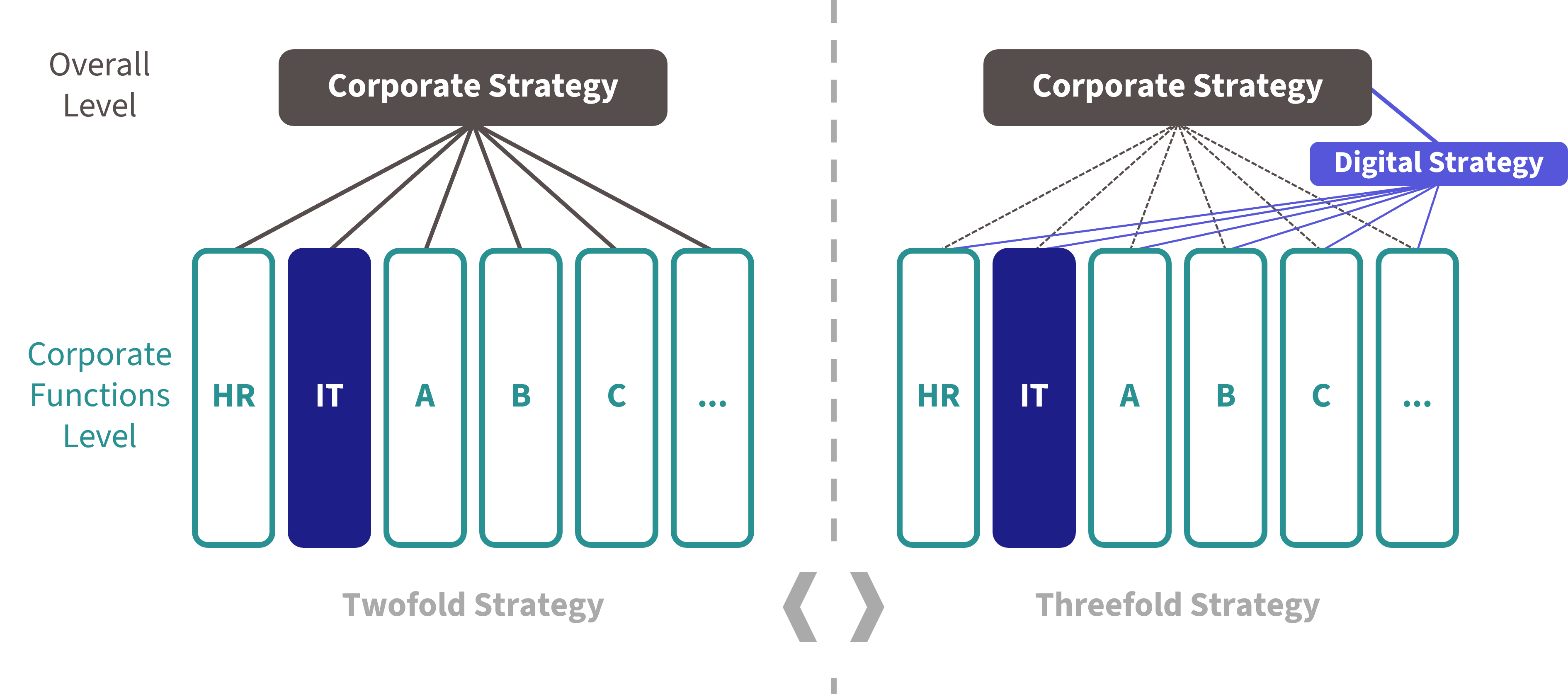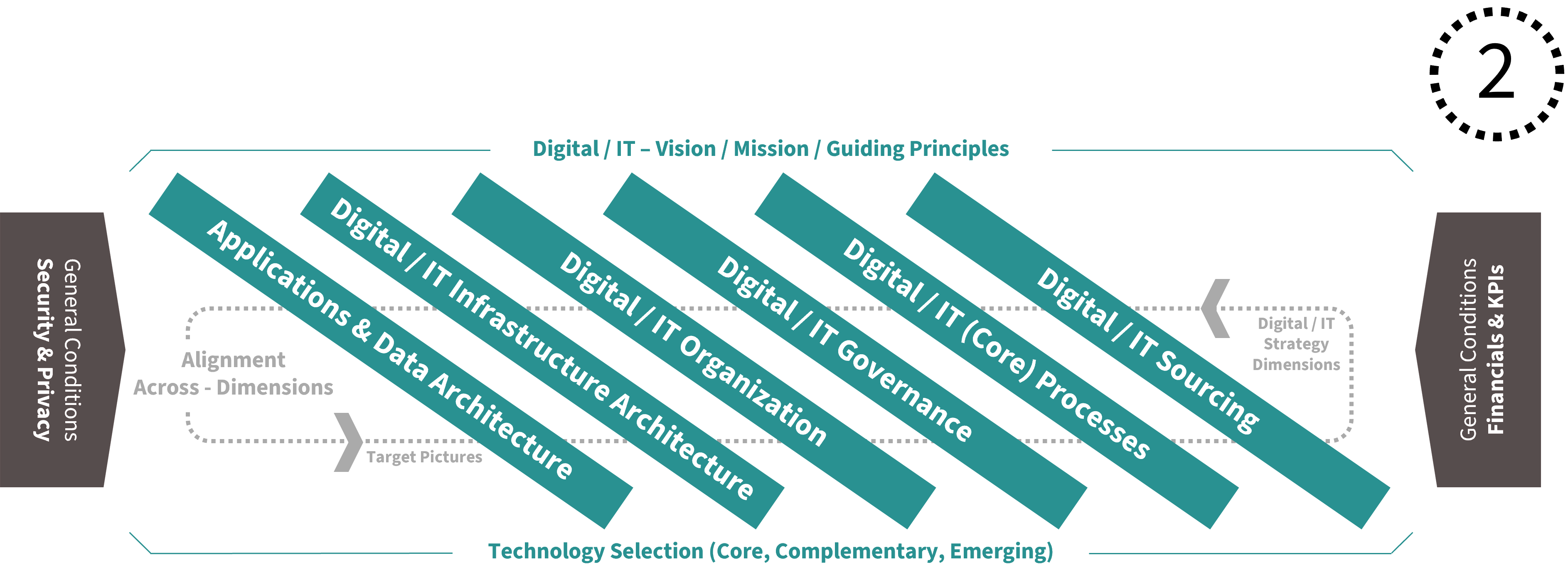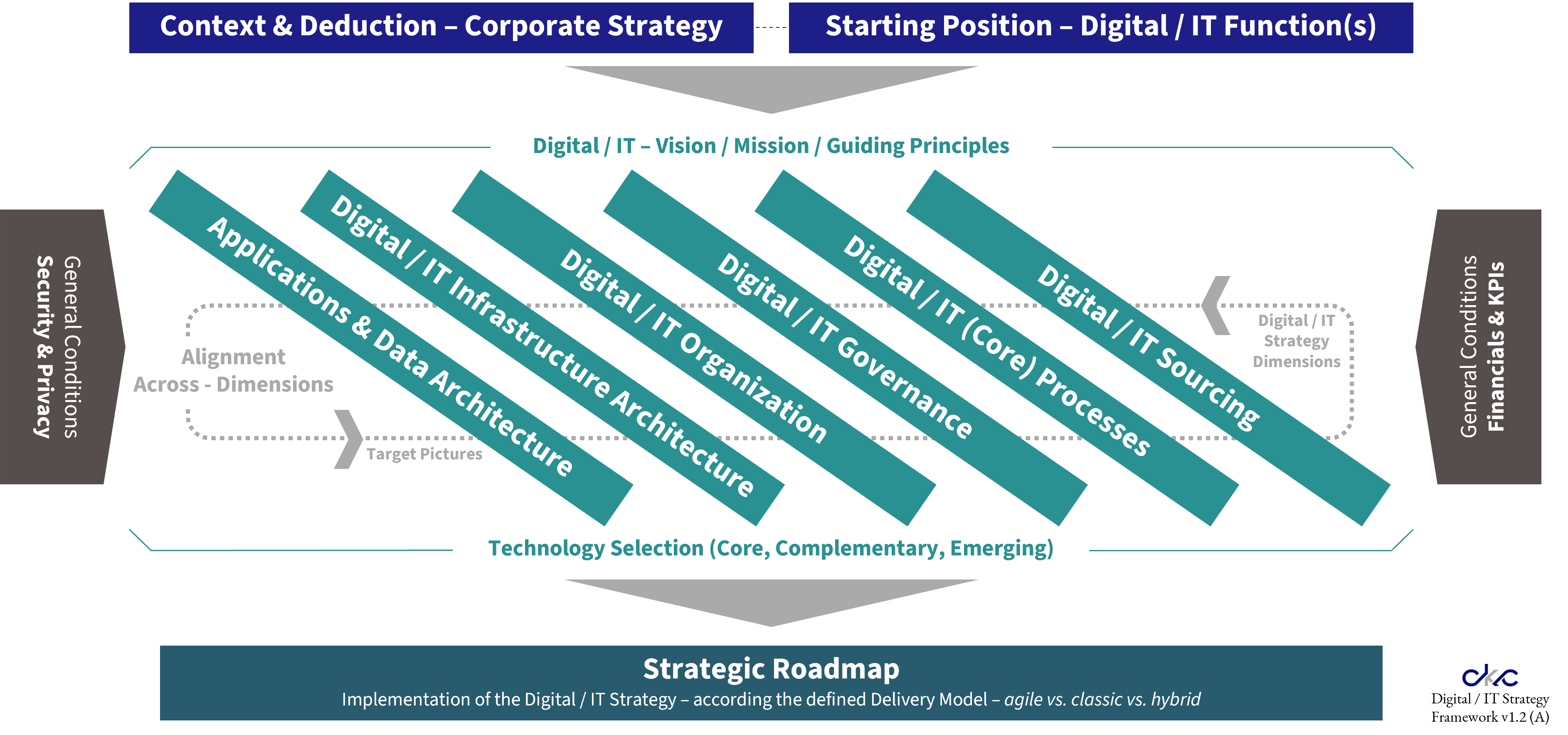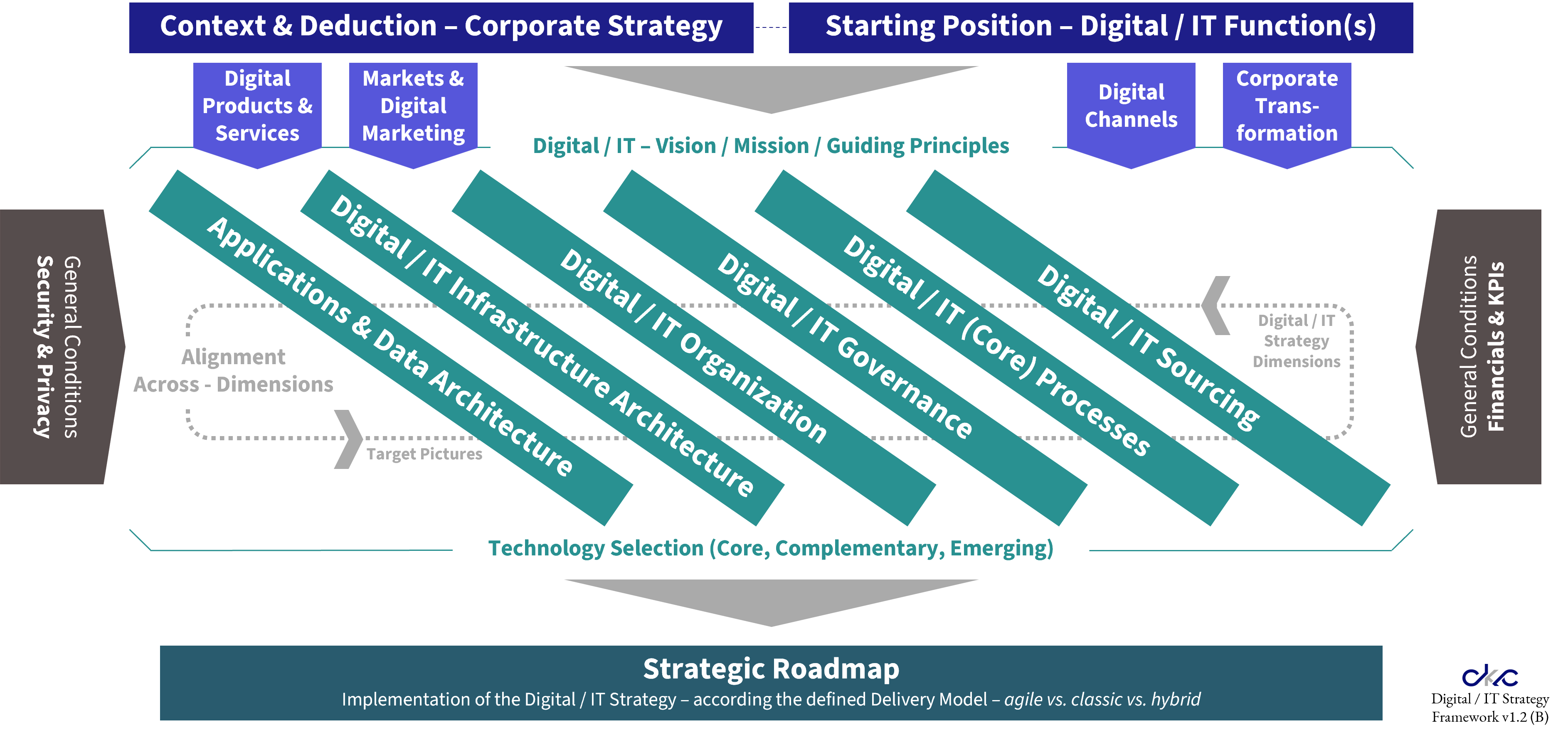An experience-based and reality-proofed framework, supporting your specific digital / IT strategy project.
CKC - Digital / IT Strategy Consulting
We recognize ourselves as a "hidden champion" for digital / IT strategy development. Christian Kaliauer has worked with many clients in various scenarios and industries. While each engagement represented an individual setting, he was able to identify patterns and experimented with different approaches tailored to the specific situation, goals, and stakeholder involvement. In the start phase of CKC, he developed the CKC digital / IT strategy framework intended as a meta framework. The framework represents the essence of how a digital / IT strategy development can be comprehensively structured and will be updated on new findings in future.
Utilizing this Meta Framework brings the Following Benefits to Our Clients
Let's dive into the CKC Digital / IT Strategy Meta Framework
The digital / IT strategy
defines and communicates
a core set of strategic elements
in the area of digital / IT
to best enable and support the overall corporate strategy
and peer business functions of the specific enterprise
for a specified period (typically 2-3 years ahead)
from the perspective of the digital / IT function.
Typical elements of a digital / IT strategy are:
- Mission / vision statement
- Guiding principles
- Strategic target pictures for specific strategic dimensions
- Strategic roadmap and brief descriptions of the key initiatives
- Additional elements depending the individual setting and preferences
Setting the stage for the digital / IT strategy project is an essential part for the overall success of the strategy development. In particular, the following aspects should be considered:
- Overall goals and ambition level
- Identified key stakeholders
- (Core) team setup
- Finalization of the project approach
- Strategy setting in the context of digital - twofold vs. threefold strategy
We currently recognize different schools of thought for considering the digital transformation in strategy development:

Twofold strategy: An overall holistic corporate strategy is supported by individual and comprehensive functional strategies, such as HR, supply chain management, IT, and other relevant corporate functions. The corporate level and the functional areas include the relevant aspects of the digital transformation.
Threefold strategy: A digital strategy covers all essential pieces of a corporate digital transformation, including topics such as digital products & services, markets, and digital marketing, digital channels, digital technologies, and a holistic approach to transform the entire organization towards the digital transformation. Corporate strategy and IT strategy are defined in a more traditional way, without considering the digital transformation in a comprehensive manner.
Note: We can work with you in both ways - twofold and threefold. Our meta framework supports both approaches with a slightly adopted model. Generally, we recommend investing more time in "setting the stage" and finalizing the project approach very consciously when a threefold strategy approach is envisioned.

Phase 1 of the digital / IT strategy development focuses on the following aspects:
- Analyze the corporate strategy in regards to relevance for the digital / IT strategy
- Understand the needs and requirements of the business functions, including their functional strategies and the respective digital potential
- Determine the starting position of the overall digital / IT function(s)
- Understand (and challenge) general corporate conditions on security, privacy, financials, and KPIs
- Understand, challenge, and adopt the guiding principles for the digital / IT function with key stakeholders
- Adopt the project approach for the next phases correspondent to the key results of phase 1 and relevant stakeholder feedback
Note: Determing the starting position of the overall digital / IT function is a specialized and focused as-is evaluation. Therefore we typically use a selected set of methods from our as-is evaluation offering.
If a threefold strategy approach in regards to considering the digital transformation is chosen, or there is a strong emphasis on specific topics of the digital transformation, additional aspects are elaborated, such as:
- Understand, (envision, and adopt) key digital products and services
- Understand (and identify further) relevant markets and the overall digital marketing approach
- Understand (and challenge) the digital channels strategy
- Understand current planning, history, and vision for the overall organizational transformation of the corporation to position toward the digital revolution
Note: When a threefold strategy approach is envisioned, we recommend investing more time in "setting the stage" and consciously finalizing the project approach.
The following image shows the core and additional elements of phase 1 to align with a threefold strategy approach:


Phase 2 of the digital / IT strategy development concentrates on the following aspects:
- Develop the digital / IT vision and mission
- Update and challenge the overall guiding principles, along with the development of the defined digital / IT strategy dimensions
- Define and adopt the utilized and envisioned technology usage (core, complementary, emerging)
- Cross align the target pictures considering the relevant dependencies
- Run feedback sessions with specific stakeholders and selected experts according to the defined project setting
- Finalize the phase 2 key deliverables
- Adopt the project approach for the next phase correspondent to the key results of phase 2 and relevant stakeholder feedback
Note: The strategy dimensions of organization, governance, and processes are also vital elements in a digital / IT operating model. Therefore we typically use a selected set of methods from our digital / IT operating model framework and work out the topics in focus at the agreed level.

In phase 3 of the digital / IT strategy development, the focus is on topics such as:
- Perform a gap analysis between the target pictures of phase 2 and the identified starting position of phase 1
- Derive key initiatives to move the digital / IT function towards the defined target pictures in the strategy
- Align with key stakeholders on strategy implementation scenarios, ambition level, priorities, and speed
- Define and agree on the strategy implementation principles
- Define and agree on the delivery model mode, including the decision whether to follow an agile paradigm, a classic paradigm or to go with a hybrid approach
- Finalize the overall digital / IT strategy deliverable and define the next steps
- Reflect on the overall strategy development process and derive conclusions for future strategy development activities
Note: Alone implementing the developed digital / IT strategy often is a challenging endeavor in large and complex corporations. It can become even more intense in conjunction with the typically occurring tactical changes, arising new requirements, and some escalating projects out of your project portfolio. Having a "protected room" to discuss specific issues could help to get clarity on your next steps and decisions. Our Executive Coaching offering could be a potential benefit to you, allowing such a "protected room" and staying in meaningful contact after the digital / IT strategy development phase.

While the development of an overall digital / IT strategy can be quite complex and challenging in practice, we apply a very intuitive approach to work with and guide our clients through their strategy development process:
- Setting the stage: Be clear on
- your overall goal
- ambition level
- and setup
- Phase 1: Understand
- how you can enable the overall corporate strategy
- the needs of your peer corporate functions
- and the as-is situation in your digital / IT unit(s)
- Phase 2: Develop
- all defined digital / IT strategy dimensions
- and target pictures
- Phase 3: Finalize
- the digital / IT strategy
- how to progress towards your strategic intent via a strategic roadmap
- and a suitable delivery model
Our CKC digital / IT strategy meta framework assists in that manner.
If your corporation pursues a threefold strategy approach with a dedicated digital strategy besides an IT strategy, we are working with an enriched model. In that case our meta framework includes topics such as:
- digital products & services
- markets, and digital marketing
- digital channels
- a holistic approach to transform the entire organization towards the digital transformation

Q: Can a digital / IT strategy be developed when the corporate strategy is not (entirely) formalized?
CKC: Yes, it can. We had several client engagements where the clients did not have a formalized corporate strategy at the time of the digital / IT strategy project. In that case, we can derive overall strategic imperatives relevant to the digital / IT strategy from the stakeholder interviews. Later on we reflected on the itermediate & final digital / IT strategy outcome with these stakeholders. Typically, we received positive feedback for having identified the relevant vital points from their overall corporate direction. One thing to add: Having a formalized and up-to-date corporate strategy available would be, of course, the better option.
Q: Does a project which follows your digital / IT meta framework typically run as a waterfall-based project, or does it follow the agile paradigm and methods?
CKC: We are a big believer in the values of the agile paradigm and the positive effects of following agile methods in suitable settings. We also recognize the classic project management methods and their positive impact when applied to applicable situations (-> refer to Stacey-matrix similar to Cynefin framework).
From our experience, the optimum method combines agile and iterative waterfall. We recommend following our key 3 phases in a consecutive sequence. These 3 phases represent the core process and the required flow to - in our opinion - have a high chance of developing a meaningful and to-the-point stated digital / IT strategy. Within each phase, your key deliverables should be worked out following an MVP approach, running multiple iterations, performing frequent demos to stakeholders, and retrospectives with the team.
Q: What is the ideal project duration and intensity? A few intensive weeks or spread out over a more extended period besides day-to-day operations?
CKC: Both approaches have their advantages.
If a more prolonged duration fits the client's setting and stakeholder expectations, we recommend spreading it out over a longer period. We see a couple of advantages, such as
(1) a higher chance of interviewing top management and senior business executives,
(2) a higher chance to involve a broader group of experts and digital / IT management,
(3) more time to reflect on intermediate work products, challenging / complex problems, and proper next steps, and
(4) higher buy-in of the involved people in the following strategy implementation period.
A short, intensive period is the better approach if the timing is critical or key personnel and stakeholder availability is limited to a particular time window. Typical scenarios for this approach would be
(1) Focus on CIO / CDO's first 100 days,
(2) short-noticed leadership changes, and
(3) short-noticed external factors such as rapid M&A activities and suddenly changed, fast striking economic conditions.
